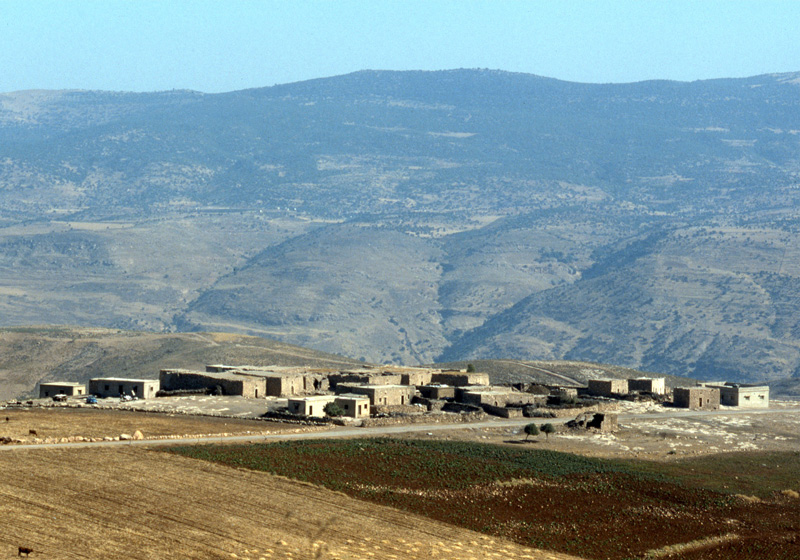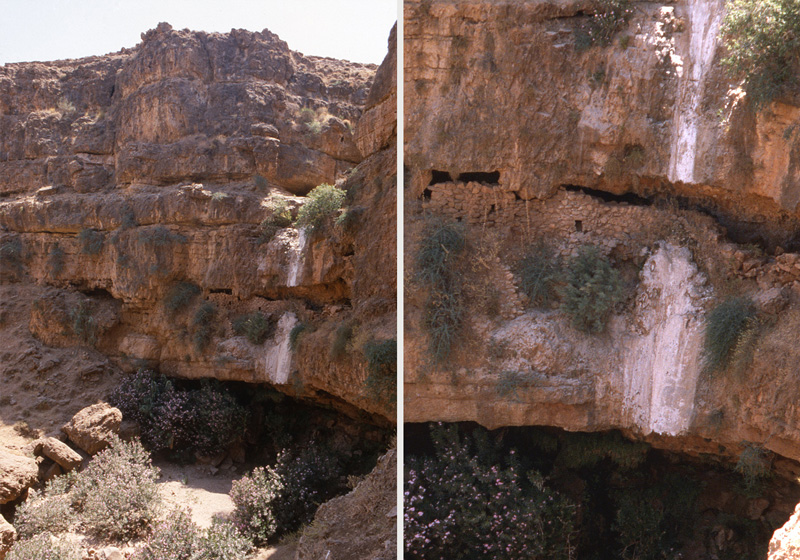House of the Waterfall
Sumia is the last of Salt villages to the north. Beyond it the landscape drops abruptly into the deep escarpments of the Zarqa River. The village itself is a charming little gathering of stone houses placed on a pedestal of bedrock surrounded by relaxed rolling hills and stretches of red-soiled plateau; the total composition is one out of a romantic book on the land of the Bible.

Towards the northwest, many intricate, oleander-furnished ravines meander. In the far background the horizon is blocked by the Ajloun Mountains, an escarpment capped with dark-green pine, standing like a wall beyond the Zarqa River. The landscape is powerful, articulated with tactile geology, washed in lime and colored by natural pigments of different minerals.
Descending on goat-tracks, you slowly find yourself in the more intimate side tributaries of the Zarqa River. This side valley was shaped by water coming from the catchment area to the west of Sumia, the water runs only in winter and, for thousands of years, has carved a deep passage into the hillsides. As the rainwater cuts into the ground, the degree of cutting is directly influenced by the hardness of rock. In some layers, where the land is built-up of soft lime, deep grooves are created. In other parts, were more solid layers of rock resist erosion, a shelf of massive dimensions interrupts the slope. This creates a terrace, a canopy, providing the landscape with an element reminiscent of man-made architecture. As that entire section of land was formed under water more than 100 million yours ago, the hardness of its sedimentary layers presents a good record of the materials that the sea was getting at different times. A hard slab of rock formed by a supply of homogenous inflow of lime sits on a soft layer of silt, sand, and clay. The gap below it is dramatically sculpted in the softer silt, leaving a hanging shelf, a ceiling few meters thick, furnished with a natural spout from which the rainwater falls into the pool below.
In this dramatic location, a modest structure was built. The locals call it Sadd Al-Rahbat, “The Dam (or Wall) of the Nuns”, or Sadd Sultaneh. The climb to the interior is somewhat dangerous, but once inside, the space is quite spiritual. Following an idea of creation and ingenuity, the builders adopted a natural structure, a ceiling, a floor and a curved back-wall. Only one man-made (or probably woman-made) wall was added to create a complete abode. This effect, from inside, is of stunning charm. From above the built wall and through its small windows you can look out into the ravine with its steep sides washed by the sun. Inside is somewhat dark and calm, with its back walls decorated by delicate ferns hiding in the shade of the mass above.

Like a private balcony with a private view, only interrupted by a winter waterfall coming from the slab above, this place is a hidden retreat; an hermitage behind a waterfall.
From the name, “Wall of the Nuns”, one might imagine that this place was once inhabited by monks, nuns, or hermits, and possibly not too long ago. A proper archaeological survey might shed more light; there must have been some farming in the surrounding hillsides, some olive presses, etc.
Jordan is a land with many dormant stories; it is a lasting excitement to discover further in a landscape we know very scantily.
Take the road in the direction of Salt, at the Zay intersection, exit to the north towards the village of Sumia, ask for direction, as this village is little known. Park at Sumia, you may have to meet some of the locals to entrust them with your car, and ask for directions to “Sadd Al Rahbat” or “Sadd Sultaneh” as the locals call it. This destination is a tough walk. From Sumia it takes 4 hour for the round trip with some hiking. There might be by now, nevertheless, a road that might get you closer, but in this case you might get someone to stay by the car for the duration of the walk. Good boots, and a light picnic snack are highly recommended.